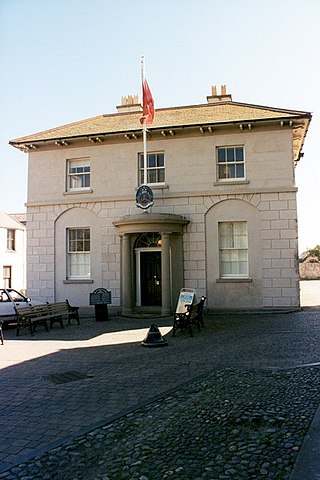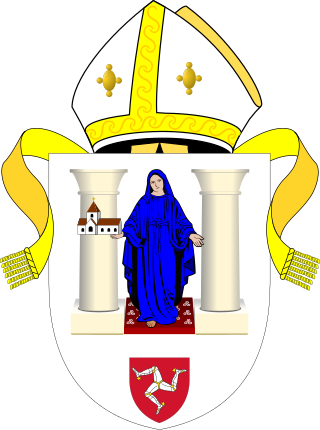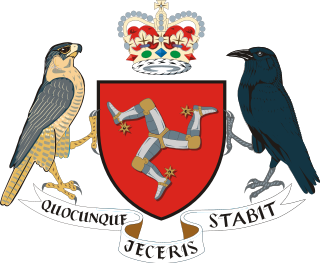
The Isle of Man had become separated from Great Britain and Ireland by 6500 BC. It appears that colonisation took place by sea sometime during the Mesolithic era. The island has been visited by various raiders and trading peoples over the years. After being settled by people from Ireland in the first millennium AD, the Isle of Man was converted to Christianity and then suffered raids by Vikings from Norway. After becoming subject to Norwegian suzerainty as part of the Kingdom of Mann and the Isles, the Isle of Man later became a possession of the Scottish and then the English crowns.
The peerages in the United Kingdom are a legal system comprising both hereditary and lifetime titles, composed of various noble ranks, and forming a constituent part of the British honours system. The term peerage can be used both collectively to refer to the entire body of nobles, and individually to refer to a specific title. British peerage title holders are termed peers of the Realm. The peerage's fundamental roles are ones of government, peers being eligible to a seat in the House of Lords, and of meritocracy, the receiving of any peerage being the highest of British honours. In the UK, five peerages or peerage divisions co-exist, namely:
Lord is an appellation for a person or deity who has authority, control, or power over others, acting as a master, chief, or ruler. The appellation can also denote certain persons who hold a title of the peerage in the United Kingdom, or are entitled to courtesy titles. The collective "Lords" can refer to a group or body of peers.

Tynwald, or more formally, the High Court of Tynwald or Tynwald Court, is the legislature of the Isle of Man. It consists of two chambers, known as the branches of Tynwald: the directly elected House of Keys and the indirectly chosen Legislative Council. When the two chambers sit together, they become "Tynwald Court".

Lord of the manor is a title that, in Anglo-Saxon England, referred to the landholder of a rural estate. The lord enjoyed manorial rights as well as seignory, the right to grant or draw benefit from the estate. The title continues in modern England and Wales as a legally recognised form of property that can be held independently of its historical rights. It may belong entirely to one person or be a moiety shared with other people.

The Diocese of Sodor and Man is a diocese of the Church of England. Originally much larger, today it covers just the Isle of Man and its adjacent islets. Today, the bishop's office is in Douglas and the cathedral is in Peel. The diocese is not generally called either "Sodor diocese" or "Man diocese".
The pound is the currency of the Isle of Man, at parity with sterling. The Manx pound is divided into 100 pence. Notes and coins, denominated in pounds and pence, are issued by the Isle of Man Government.

John Murray, 3rd Duke of Atholl, KT, PC, known as John Murray until 1764, was a Scottish peer and Tory politician.

John Murray, 4th Duke of Atholl, KT, PC, FRS, styled Marquess of Tullibardine from 1764 to 1774, was a Scottish peer.
An Act of Tynwald is a statute passed by Tynwald, the parliament of the Isle of Man.

The South Australia Act 1834, or Foundation Act 1834 and also known as the South Australian Colonization Act, was an Act of the Parliament of the United Kingdom which provided for the settlement of a province or multiple provinces on the lands between 132 degrees east and 141 degrees of east longitude, and between the Southern Ocean, and 26 degrees south latitude, including the islands adjacent to the coastline.

Keppel Gate, Isle of Man is part of a former UK HM Commissioners of Woods and Forest estate, including a series of former highway mountain gates. It is now Common land in public ownership and is one of three purpose built former Crown Road sections of the A18 Snaefell Mountain Road used for the Isle of Man TT races. The area of Keppel Gate including a nearby private residence of Kate's Cottage at the adjacent 34th TT Milestone road-side marker is located between the 4th Milestone and 5th Milestone road-side markers on the primary A18 Snaefell Mountain Road in the parish district of Kirk Onchan in the Isle of Man.
An Appropriation Act is an Act of the Parliament of the United Kingdom which, like a Consolidated Fund Act, allows the Treasury to issue funds out of the Consolidated Fund. Unlike a Consolidated Fund Act, an Appropriation Act also "appropriates" the funds, that is allocates the funds issued out of the Consolidated Fund to individual government departments and Crown bodies. Appropriation Acts were formerly passed by the Parliament of Great Britain.
Events from the year 1765 in Great Britain.

The Bishoprics of Chester and Man Act 1541 was an Act of the Parliament of England that transferred the jurisdiction over the Dioceses of Chester and Sodor and Man from the Archdiocese of Canterbury to the Archdiocese of York.

Kate's Cottage, Isle of Man is a cottage and one of the named corners of the Snaefell Mountain Course used in Grand Prix-style motorcycle racing along public roadways of the Isle of Man. It has been asserted in the Isle of Man's program of Registered Buildings that the cottage was built by 1869.

The Lieutenant Governor of the Isle of Man is the Lord of Mann's official personal representative in the Isle of Man. He has the power to grant royal assent and is styled "His Excellency".

The Lord of Mann is the lord proprietor and head of state of the Isle of Man. The current lord proprietor and head of state is Charles III. Before 1504 the head of state was known as King of Mann.

Cornelius Smelt was an administrator who served as Lieutenant Governor of the Isle of Man from 1805 until his death in 1832, the longest governorship in the history of the Island. An officer in the British Army, he served first with the 14th Regiment of Foot and then the 35th Regiment of Foot, acting as Deputy Governor of Southsea Castle in the late 18th century. His governorship of the Isle of Man is remembered as one in which he displayed great moral courage in difficult circumstances. His wisdom and fortitude in the long period when the House of Keys and the Duke of Atholl fought their historic political battles were also evident. Upon his death, a memorial was erected in Castletown in the Isle of Man.













